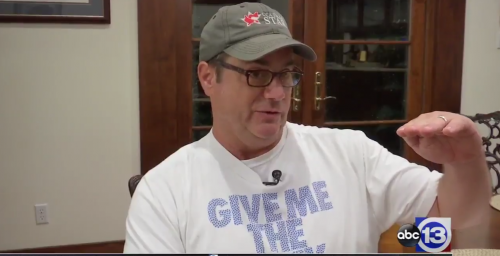While they’ve been out covering flooding from Hurricane Harvey in Houston, photographers have gone way beyond capturing video and still images.
During its nonstop coverage in the past few days, KTRK-TV in Houston turned to a technique I first saw when Miami stations covered Hurricane Andrew 25 years ago. The station told its photojournalists to pin on a live microphone and explain what they were seeing on the air.
“When we hire people, we hire them with the understanding that everyone is a content contributor,” said Wendy Granato, news director at KTRK. “In some ways, what we are doing this week is a continuation of what we have learned from being live on social media. Everybody knows that at some point, they might be an on-air and on-live online person.”

KTRK Sports producer/photojournalist Joe Gleason was rescued after he reported live from his flooded home.
The live connections paid off for KTRK sports producer and photographer Joe Gleason. His home is surrounded by the flooded Buffalo Bayou, and water washed into his living room and kept rising.
Rescuers didn’t hear his cries for help. So, he did what any thinking journalist would do — he fired up his TV camera and remote transmitter attachment for a live report on Channel 13. Within an hour of the live TV report, rescue crews were at his door to get him and his family out.
The walk-and-talk technique is possible now because TV stations use a technology called “bonded cellular.” It makes any TV camera a live-on-the-air camera. Journalists can just hook the camera into a cigar box-sized device that connects to cell services and transmits high-quality video and audio. Justin Sternberg, executive producer at KTRK, hooked one of the station’s Dejero live units to his smartphone and headed for flooded streets to report live. “It was just him out there in his Jeep showing us the streets,” Granato said.
The bonded cellular technology is just the latest example of the ways journalists have to evolve with the times, said Bernard Francis, chief photographer and news operations manager at KTRK.
“I have been in the business 33 years at this station. I came up old school and learned you have to change the ways we do things,” he said. “At some point our people can’t even get out of their neighborhood, so they can be reporters until they can.”
Willie Dixon, a photographer, was coming from home from covering a Texans preseason football game and came upon an armada of boats that civilians were launching to rescue. Dixon went live, describing what he saw while he was shooting it. Chris Nocera, another KTRK photographer, has been reporting live from rescue boats for the last two days. Photographer Mario Segura could not get out of his neighborhood, so he gave a walking tour live on TV.
Francis remembers a day when television photographers were out of business when they were out of battery power.
“We are not just in live trucks anymore,” he said. “We are in SUVs with inverters that allow us to charge batteries that we used to have to plug into a wall or a live truck. That change revolutionized what we do, we always have fresh batteries. We can go wall-to-wall.”
KTRK has a routine that makes it easier for crews to stay air-ready. When a crew comes back to the station, they leave the camera and microphones with the maintenance team, even if there’s nothing wrong. Then, the team checks it to make sure it’s ready to go back out while the crew is sleeping.
“We also tell our people, ‘if you are not being used right now, get back in your truck,'” Francis said. “…Keep people dry and safe, that’s the key to being ready to go.”
KTRK’s insistence that every newsroom employee be “air-ready” has shaped the questions that Granato asks when she hires people. “I ask three basic questions,” she said. “First, are you willing to work any day and any shift any time? Second, Do you love creating content? And third, are you comfortable being on the air or reporting on digital? It is the world we live in. We are everywhere all the time.”







